Suchergebnisse für "the OR raspberry OR pi OR zero OR 2 OR w OR go OR book"
-

Elektor Digital The Raspberry Pi Zero 2 W GO! Book (PDF)
A Fast-Lane Ride From Concept to Project The core of the book explains the use of the Raspberry Pi Zero 2 W running the Python programming language, always in simple terms and backed by many tested and working example projects. On part of the reader, familiarity with the Python programming language and some experience with one of the Raspberry Pi computers will prove helpful. Although previous electronics experience is not required, some knowledge of basic electronics is beneficial, especially when venturing out to modify the projects for your own applications. Over 30 tested and working hardware-based projects are given in the book, covering the use of Wi-Fi, communication with smartphones and with a Raspberry Pi Pico W computer. Additionally, there are Bluetooth projects including elementary communication with smartphones and with the popular Arduino Uno. Both Wi-Fi and Bluetooth are key features of the Raspberry Pi Zero 2 W. Some of the topics covered in the book are: Raspberry Pi OS installation on an SD card Python program creation and execution on the Raspberry Pi Zero 2 W Software-only examples of Python running on the Raspberry Pi Zero 2 W Hardware-based projects including LCD and Sense HAT interfacing UDP and TCP Wi-Fi based projects for smartphone communication UDP-based project for Raspberry Pi Pico W communication Flask-based webserver project Cloud storage of captured temperature, humidity, and pressure data TFT projects Node-RED projects Interfacing to Alexa MQTT projects Bluetooth-based projects for smartphone and Arduino Uno communications
€ 32,95
Mitglieder € 26,36
-
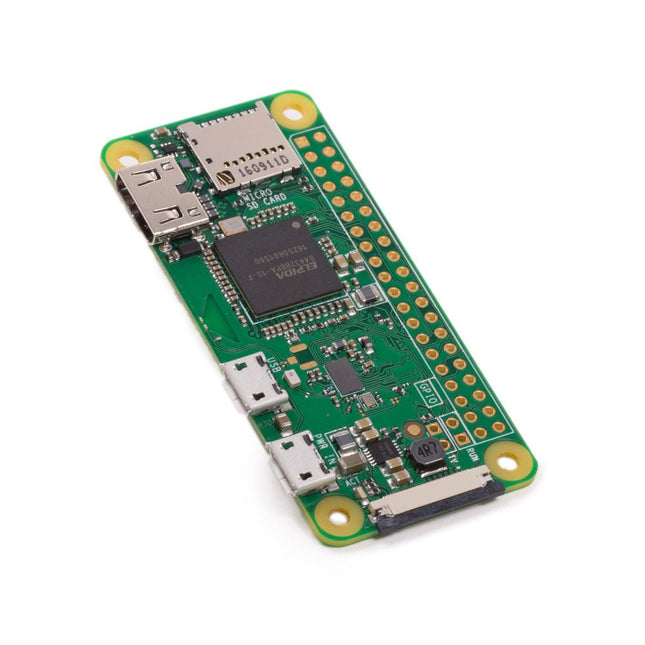
Raspberry Pi Foundation Raspberry Pi Zero W
Der Raspberry Pi Zero W erweitert die Raspberry Pi Zero-Familie. Der Raspberry Pi Zero W hat alle Funktionen des ursprünglichen Raspberry Pi Zero, kommt aber mit zusätzlichen Anschlussmöglichkeiten bestehend aus: 802.11 b/g/n wireless LAN Bluetooth 4.1 Bluetooth Low Energy (BLE) Weitere Features 1 GHz, Single-Core-CPU 512 MB RAM Mini HDMI und USB On-The-Go Anschlüsse Micro-USB power HAT-compatible 40-pin header Composite-Video- und Reset-Anschlüsse CSI-Kamera-Anschluss Downloads Mechanical Drawing Schematics
€ 17,95€ 8,95
Mitglieder identisch
-

Elektor Publishing Raspberry Pi Pico W (Book)
Program, build, and master 60+ projects with the Wireless RP2040 The Raspberry Pi Pico and Pico W are based on the fast, efficient, and low-cost dual-core ARM Cortex M0+ RP2040 microcontroller chip running at up to 133 MHz and sporting 264 KB of SRAM and 2 MB of Flash memory. Besides spacious memory, the Pico and Pico W offer many GPIO pins, and popular peripheral interface modules like ADC, SPI, I²C, UART, PWM, timing modules, a hardware debug interface, and an internal temperature sensor. The Raspberry Pi Pico W additionally includes an on-board Infineon CYW43439 Bluetooth and Wi-Fi chipset. At the time of writing this book, the Bluetooth firmware was not yet available. Wi-Fi is however fully supported at 2.4 GHz using the 802.11b/g/n protocols. This book is an introduction to using the Raspberry Pi Pico W in conjunction with the MicroPython programming language. The Thonny development environment (IDE) is used in all of the 60+ working and tested projects covering the following topics: Installing the MicroPython on Raspberry Pi Pico using a Raspberry Pi or a PC Timer interrupts and external interrupts Analogue-to-digital converter (ADC) projects Using the internal temperature sensor and external sensor chips Using the internal temperature sensor and external temperature sensor chips Datalogging projects PWM, UART, I²C, and SPI projects Using Bluetooth, WiFi, and apps to communicate with smartphones Digital-to-analogue converter (DAC) projects All projects are tried & tested. They can be implemented on both the Raspberry Pi Pico and Raspberry Pi Pico W, although the Wi-Fi-based subjects will run on the Pico W only. Basic programming and electronics experience are required to follow the projects. Brief descriptions, block diagrams, detailed circuit diagrams, and full MicroPython program listings are given for all projects.
€ 44,95
Mitglieder identisch
-
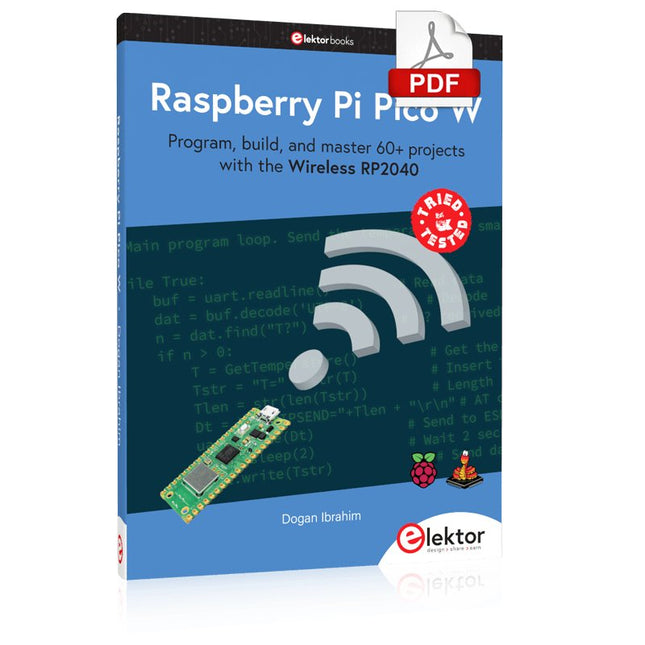
Elektor Digital Raspberry Pi Pico W (E-Book)
Program, build, and master 60+ projects with the Wireless RP2040 The Raspberry Pi Pico and Pico W are based on the fast, efficient, and low-cost dual-core ARM Cortex M0+ RP2040 microcontroller chip running at up to 133 MHz and sporting 264 KB of SRAM and 2 MB of Flash memory. Besides spacious memory, the Pico and Pico W offer many GPIO pins, and popular peripheral interface modules like ADC, SPI, I²C, UART, PWM, timing modules, a hardware debug interface, and an internal temperature sensor. The Raspberry Pi Pico W additionally includes an on-board Infineon CYW43439 Bluetooth and Wi-Fi chipset. At the time of writing this book, the Bluetooth firmware was not yet available. Wi-Fi is however fully supported at 2.4 GHz using the 802.11b/g/n protocols. This book is an introduction to using the Raspberry Pi Pico W in conjunction with the MicroPython programming language. The Thonny development environment (IDE) is used in all of the 60+ working and tested projects covering the following topics: Installing the MicroPython on Raspberry Pi Pico using a Raspberry Pi or a PC Timer interrupts and external interrupts Analogue-to-digital converter (ADC) projects Using the internal temperature sensor and external sensor chips Using the internal temperature sensor and external temperature sensor chips Datalogging projects PWM, UART, I²C, and SPI projects Using Bluetooth, WiFi, and apps to communicate with smartphones Digital-to-analogue converter (DAC) projects All projects are tried & tested. They can be implemented on both the Raspberry Pi Pico and Raspberry Pi Pico W, although the Wi-Fi-based subjects will run on the Pico W only. Basic programming and electronics experience are required to follow the projects. Brief descriptions, block diagrams, detailed circuit diagrams, and full MicroPython program listings are given for all projects.
€ 34,95
Mitglieder € 27,96
-

Raspberry Pi Foundation Raspberry Pi Pico 2 W
Der Raspberry Pi Pico 2 W ist ein Mikrocontroller-Board auf Basis des RP2350 mit 2,4 GHz 802.11n Wireless LAN und Bluetooth 5.2. Es gibt Ihnen noch mehr Flexibilität bei Ihren IoT- oder Smart-Produktdesigns und erweitert die Möglichkeiten für Ihre Projekte. Der RP2350 bietet eine umfassende Sicherheitsarchitektur rund um Arm TrustZone für Cortex-M. Es umfasst signiertes Booten, 8 KB Antifuse-OTP für die Schlüsselspeicherung, SHA-256-Beschleunigung, einen Hardware-TRNG und schnelle Glitch-Detektoren. Die einzigartige Dual-Core- und Dual-Architektur-Fähigkeit des RP2350 ermöglicht Benutzern die Wahl zwischen einem Paar ARM Cortex-M33-Kernen nach Industriestandard und einem Paar Hazard3 RISC-V-Kernen mit offener Hardware. Der Raspberry Pi Pico 2 W ist in C/C++ und Python programmierbar und wird durch eine ausführliche Dokumentation unterstützt. Er ist das ideale Mikrocontroller-Board sowohl für Enthusiasten als auch für professionelle Entwickler. Technische Daten CPU Dual Arm Cortex-M33 oder Dual RISC-V Hazard3 Prozessoren bei 150 MHz Wireless On-Board Infineon CYW43439 Single-Band 2,4 GHz 802.11n Wireless Lan und Bluetooth 5.2 Speicher 520 KB On-Chip-SRAM; 4 MB integrierter QSPI-Flash Schnittstellen 26 Mehrzweck-GPIO-Pins, darunter 4, die für AD verwendet werden können Peripherie 2x UART 2x SPI-Controller 2x I²C-Controller 24x PWM-Kanäle 1x USB 1.1-Controller und PHY, mit Host- und Geräteunterstützung 12x PIO-Zustandsmaschinen Eingangsspannung 1,8-5,5 V DC Abmessungen 21 x 51 mm Downloads Datasheet Pinout Schematic
€ 7,95
Mitglieder identisch
-

Elektor Bundles Raspberry Pi Bundle: Zero W + Buffer Board
Dieses Bundle enthält das Raspberry Pi Zero W sowie das Elektor Raspberry Pi Buffer Board. Raspberry Pi Zero W Der Raspberry Pi Zero W erweitert die Raspberry Pi Zero-Familie. Der Raspberry Pi Zero W hat alle Funktionen des ursprünglichen Raspberry Pi Zero, kommt aber mit zusätzlichen Anschlussmöglichkeiten bestehend aus: 802.11 b/g/n wireless LAN Bluetooth 4.1 Bluetooth Low Energy (BLE) Weitere Features 1 GHz, Single-Core-CPU 512 MB RAM Mini HDMI und USB On-The-Go Anschlüsse Micro-USB power HAT-compatible 40-pin header Composite-Video- und Reset-Anschlüsse CSI-Kamera-Anschluss Downloads Mechanical Drawing Schematics Elektor Raspberry Pi Buffer Board Wenn Sie regelmäßig mit dem Raspberry Pi experimentieren und eine Vielzahl von externer Hardware über die Stiftleiste an den GPIO-Port anschließen, haben Sie in der Vergangenheit vielleicht schon einige Schäden verursacht. Das Raspberry Pi Buffer Board ist dazu da, dies zu verhindern! Das Board ist kompatibel mit Raspberry Pi Zero, 3, 4, 5 und 400. Alle 26 GPIOs sind mit bidirektionalen Spannungswandlern gepuffert, um den Raspberry Pi beim Experimentieren mit neuen Schaltungen zu schützen. Die Platine ist dafür vorgesehen, auf der Rückseite des Raspberry Pi 400 eingesetzt zu werden. Der Stecker zum Anschluss an den Raspberry Pi ist eine rechtwinklige 40-polige Buchse (2x20). Die Platine ist nur ein wenig breiter. An die Pufferausgangsbuchse kann ein 40-poliges Flachbandkabel mit entsprechenden 2x20-Steckern angeschlossen werden, um z. B. mit einer Schaltung auf einem Breadboard oder einer Platine zu experimentieren. Die Schaltung verwendet vier TXS0108E ICs von Texas Instruments. Die Platine lässt sich auch auf einem Raspberry Pi 3 oder neuer aufstellen. Downloads Schematics Layout
€ 52,95€ 44,95
Mitglieder identisch
-
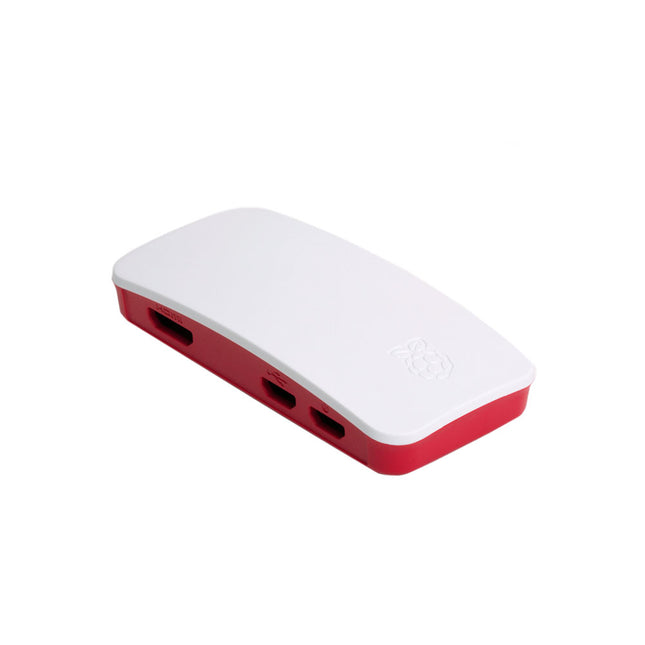
Raspberry Pi Foundation Offizielles Gehäuse für Raspberry Pi Zero
Der Koffer besteht aus zwei Teilen. Es verfügt über eine Standardbasis mit einer Aussparung für den Zugriff auf den GPIO und eine Auswahl von drei Deckeln: einen einfachen Deckel, einen GPIO-Deckel (der den Zugriff auf den GPIO von oben ermöglicht) und einen Kameradeckel (der bei Verwendung geöffnet wird). Mit dem mitgelieferten kurzen Kamerakabel kann die Raspberry Pi-Kamera oder Camera Noir sauber darin untergebracht werden. Inbegriffen 1x Basis 3x Deckel (einfach, GPIO, Kamera) 1x kurzes Kamerakabel 4x Gummifüße
€ 7,95
Mitglieder identisch
-
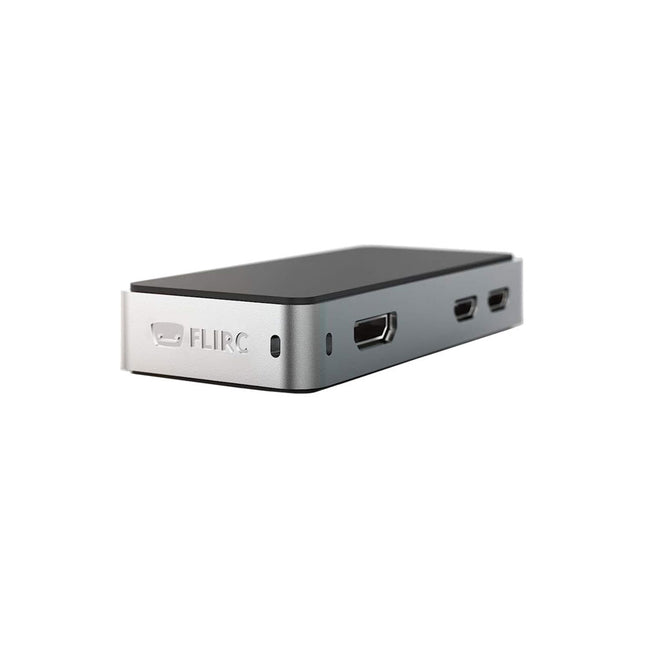
FLIRC FLIRC Case für Raspberry Pi Zero
Das FLIRC Raspberry Pi Zero Case ist kompatibel mit Raspberry Pi Zero W und dem neueren Raspberry Pi Zero 2 W. Das Design des FLIRC Zero Case basiert auf dem Original-FLIRC-Gehäuse. Wie beim Original dient das Aluminiumgehäuse als Schutz und dank der Kontaktstelle am Prozessor als passiver Kühler. Ideal für geräuschlosen Betrieb. Zusätzlich zu einer normalen Abdeckung, die den Raspberry Pi Zero umschließt und schützt, gibt es eine zweite Abdeckung, die durch eine kleine Öffnung den Zugriff auf die GPIO-Pins ermöglicht.
€ 18,95
Mitglieder € 17,06
-
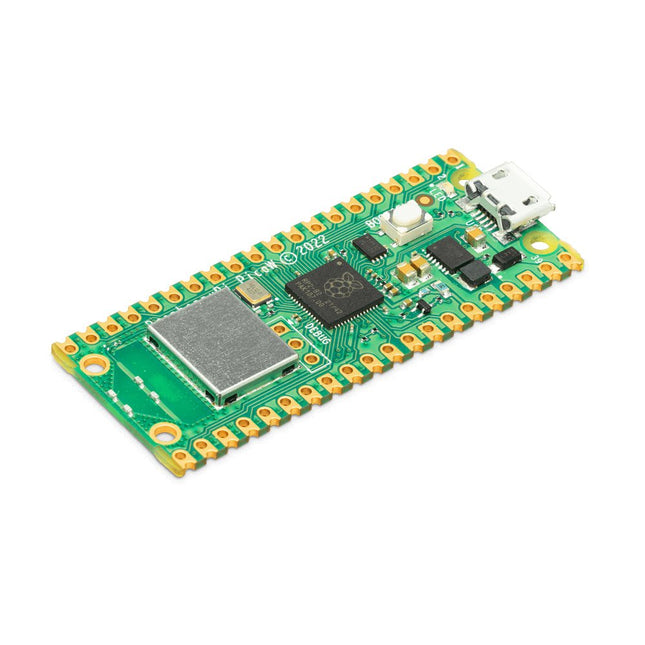
Raspberry Pi Foundation Raspberry Pi Pico W
Raspberry Pi Pico W ist ein Mikrocontroller-Board, das auf dem Mikrocontroller-Chip Raspberry Pi RP2040 basiert. Der Mikrocontroller-Chip RP2040 ("Raspberry Silicon") bietet einen Dual-Core-ARM-Cortex-M0+-Prozessor (133 MHz), 256 KB RAM, 30 GPIO-Pins und viele andere Schnittstellenoptionen. Darüber hinaus gibt es 2 MB integrierten QSPI-Flash-Speicher für Code- und Datenspeicherung. Raspberry Pi Pico W wurde als kostengünstige und dennoch flexible Plattform für RP2040 mit einer drahtlosen 2,4-GHz-Schnittstelle unter Verwendung eines Infineon CYW43439 entwickelt. Die Funkschnittstelle wird über SPI mit dem RP2040 verbunden. Features von Pico W RP2040-Mikrocontroller mit 2 MB Flash-Speicher Integrierte 2,4-GHz-Single-Band-Wireless-Schnittstellen (802.11n) Micro-USB-B-Anschluss für Strom und Daten (und zur Neuprogrammierung des Flash) 40-polige 21 x 51 mm 'DIP'-Stil, 1 mm dicke PCB mit 0,1" Durchgangslochstiften, auch mit Randkerben Bietet 26 multifunktionale 3,3-V-Universal-I/O (GPIO) 23 GPIO sind rein digital, wobei drei auch ADC-fähig sind Kann als Modul auf der Oberfläche montiert werden 3-poliger ARM Serial Wire Debug (SWD) Port Einfache, aber hochflexible Stromversorgungsarchitektur Verschiedene Optionen zur einfachen Stromversorgung des Geräts über Micro-USB, externe Netzteile oder Batterien Hohe Qualität, niedrige Kosten, hohe Verfügbarkeit Umfassendes SDK, Softwarebeispiele und Dokumentation Features von RP2040-Mikrocontroller Dual-Core-Cortex M0+ mit bis zu 133 MHz On-Chip-PLL ermöglicht eine variable Kernfrequenz 264 kByte Multibank-Hochleistungs-SRAM Externer Quad-SPI-Flash mit eXecute In Place (XIP) und 16 KB On-Chip-Cache Hochleistungs-Full-Crossbar-Busgewebe On-Board USB1.1 (Gerät oder Host) 30 Multifunktions-Allzweck-I/O (vier können für ADC verwendet werden) 1,8-3,3 V I/O-Spannung 12-Bit 500 ksps Analog-Digital-Wandler (ADC) Verschiedene digitale Peripheriegeräte 2x UART, 2x I²C, 2x SPI, 16x PWM-Kanäle 1 Timer mit 4 Alarmen, 1 Echtzeituhr 2x programmierbare I/O-Blöcke (PIO), insgesamt 8 Zustandsmaschinen Flexible, benutzerprogrammierbare Hochgeschwindigkeits-I/O Kann Schnittstellen wie SD-Karte und VGA emulieren Hinweis: Raspberry Pi Pico W I/O-Spannung ist auf 3,3 V festgelegt. Downloads Datasheet Specifications of 3-pin Debug Connector
€ 7,95
Mitglieder identisch
-
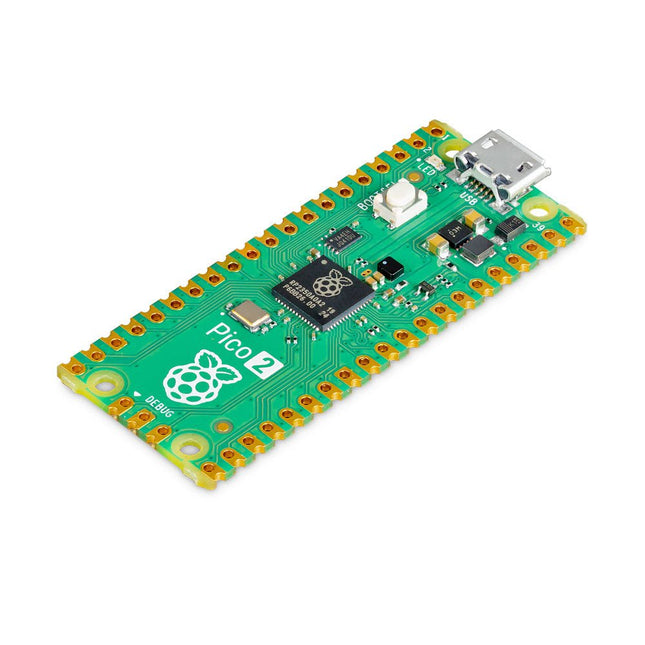
Raspberry Pi Foundation Raspberry Pi Pico 2
Der Raspberry Pi Pico 2 ist ein neues Mikrocontroller-Board der Raspberry Pi Foundation, basierend auf dem RP2350. Es verfügt über eine höhere Kerntaktrate, doppelt so viel On-Chip-SRAM, doppelt so viel On-Board-Flash-Speicher, leistungsstärkere Arm-Kerne, optionale RISC-V-Kerne, neue Sicherheitsfunktionen und verbesserte Schnittstellenfunktionen. Der Raspberry Pi Pico 2 bietet eine deutliche Steigerung der Leistung und Funktionen und behält gleichzeitig die Hardware- und Softwarekompatibilität mit früheren Mitgliedern der Raspberry Pi Pico-Serie bei. Der RP2350 bietet eine umfassende Sicherheitsarchitektur rund um Arm TrustZone für Cortex-M. Es umfasst signiertes Booten, 8 KB Antifuse-OTP für die Schlüsselspeicherung, SHA-256-Beschleunigung, einen Hardware-TRNG und schnelle Glitch-Detektoren. Die einzigartige Dual-Core- und Dual-Architektur-Fähigkeit des RP2350 ermöglicht Benutzern die Wahl zwischen einem Paar ARM Cortex-M33-Kernen nach Industriestandard und einem Paar Hazard3 RISC-V-Kernen mit offener Hardware. Der Raspberry Pi Pico 2 ist in C/C++ und Python programmierbar und wird durch eine ausführliche Dokumentation unterstützt. Er ist das ideale Mikrocontroller-Board sowohl für Enthusiasten als auch für professionelle Entwickler. Technische Daten CPU Dual Arm Cortex-M33 oder Dual RISC-V Hazard3 Prozessoren bei 150 MHz Speicher 520 KB On-Chip-SRAM; 4 MB integrierter QSPI-Flash Schnittstellen 26 Mehrzweck-GPIO-Pins, darunter 4, die für AD verwendet werden können Peripheriegeräte 2x UART 2x SPI-Controller 2x I²C-Controller 24x PWM-Kanäle 1x USB 1.1-Controller und PHY, mit Host- und Geräteunterstützung 12x PIO-Zustandsmaschinen Eingangsspannung 1,8-5,5 V DC Abmessungen 21 x 51 mm Downloads Datasheet (Pico 2) Datasheet (RP2350)
€ 5,95
Mitglieder identisch
-

The Pi Hut ZeroDock – Prototyping Dock für Raspberry Pi Zero
Die Standardkonfiguration bietet Platz für ein Mini-Breadboard (im Lieferumfang enthalten), einen SD -Kartenadapter, 2x Micro-SD-Karten, 2x USB-Geräte, ein Micro-USB-Shim und natürlich den Raspberry Pi Zero selbst. Der Benutzer kann den Micro-USB-Shim-Steckplatz für einen Micro-HDMI-Adapter verwenden oder eine Portsplus- oder ähnliche GPIO-Referenzkarte in den SD-Adaptersteckplatz stecken. Sie können Ihren USB-Micro-SD-Kartenleser oder sogar andere größere USB-Geräte wie den USBDoctor darin unterbringen. Verwenden Sie es so, wie es für Sie am besten funktioniert. Alle Anschlüsse des Raspberry Pi Zero sind vom ZeroDock aus zugänglich, einschließlich des Kameraanschlusses und der Reset-/Kompositstiftleiste. pHATs werden ebenfalls nicht behindert, so dass Sie mit Ihren bevorzugten Zusatzplatinen Prototypen erstellen können. Das Gehäuse ist eine elegante Mischung aus klaren und schwarzen Acrylschichten, schwarzen Befestigungen und einem klaren Breadboard, das gut zu den meisten Desktop-PCs/Monitoren passt. Eine Anleitung zum Zusammenbau finden Sie hier. Lieferumfang 4 Schichten lasergeschnittenes Acrylgehäuse Gehäuse- und Raspberry Pi-Befestigungen Mini-Breadboard
€ 14,95
Mitglieder € 13,46
-
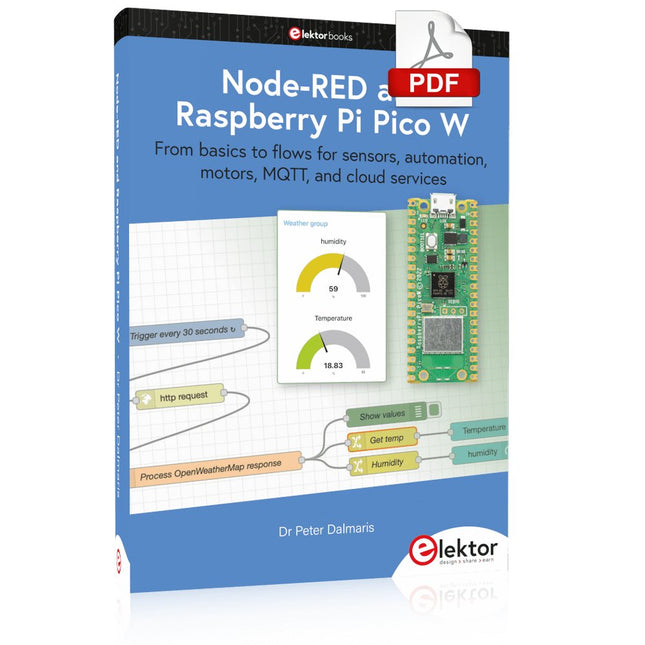
Elektor Digital Node-RED and Raspberry Pi Pico W (E-book)
From basics to flows for sensors, automation, motors, MQTT, and cloud services This book is a learning guide and a reference. Use it to learn Node-RED, Raspberry Pi Pico W, and MicroPython, and add these state-of-the-art tools to your technology toolkit. It will introduce you to virtual machines, Docker, and MySQL in support of IoT projects based on Node-RED and the Raspberry Pi Pico W. This book combines several elements into a platform that powers the development of modern Internet of Things applications. These elements are a flow-based server, a WiFi-enabled microcontroller, a high-level programming language, and a deployment technology. Combining these elements gives you the tools you need to create automation systems at any scale. From home automation to industrial automation, this book will help you get started. Node-RED is an open-source flow-based development tool that makes it easy to wire together devices, APIs, and online services. Drag and drop nodes to create a flowchart that turns on your lights at sunset or sends you an email when a sensor detects movement. Raspberry Pi Pico W is a version of the Raspberry Pi Pico with added 802.11n Wi-Fi capability. It is an ideal device for physical computing tasks and an excellent match to the Node-RED. Quick book facts Project-based learning approach. Assumes no prior knowledge of flow-based programming tools. Learn to use essential infrastructure tools in your projects, such as virtual machines, Docker, MySQL and useful web APIs such as Google Sheets and OpenWeatherMap. Dozens of mini-projects supported by photographs, wiring schematics, and source code. Get these from the book GitHub repository. Step-by-step instructions on everything. All experiments are based on the Raspberry Pi Pico W. A Wi-Fi network is required for all projects. Hardware (including the Raspberry Pi Pico W) is available as a kit. Downloads GitHub
€ 39,95
Mitglieder € 31,96











